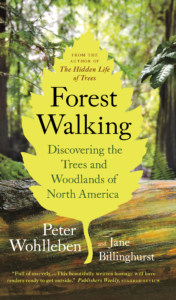
“Total Immersion” from Forest Walking
As soon as you step into a forest, you step into a different space. Depending on the type of forest, the trees may be growing together so closely that their tops almost touch. Outside, the sun may be shining brightly, but here, you are in the shade. The leaves are busily absorbing sunlight to make food. What little light makes it through the canopy is mostly green, so it feels as though you are slipping into an underwater world. The forest is refreshingly cool.
Years of discarded leaves and needles have turned the ground into a huge sponge that absorbs rainwater as it drips through the leaves and then slowly releases it into the forest floor. Above ground, you breathe in damp air, while below ground, the trees tap into the pockets of moisture captured by their maze of roots after the last rains fell. Fallen branches and trunks lie strewn on the forest floor. Rain-saturated rotting wood and downed logs steam as the sun hits them. The trees, both living and dead, are actively creating the cool, shady, moist conditions they most enjoy.
Let your eyes adjust to the quality of light around you and listen as the breeze brushes through the branches. It sounds like traffic on a distant highway, water cascading over rocks, or waves breaking on the shore. Individual trees creak and groan as they rub against one another, each producing a slightly different sound depending on how slowly or quickly, how densely or airily their wood has grown. You might even hear a hollow tree humming as though it’s experimenting with the beginnings of a tune. Leaves and needles whisper and sing. Dry leaves hanging on young beeches chatter in the brisk spring air while they wait for the larger trees in the forest to leaf out. Unfolded aspen leaves produce a muffled muttering as the breeze turns them one way and then the other. The stems of most leaves are round to keep the tops of the leaves oriented to the sun, but the stems of aspen leaves are flat, allowing the leaves to twist in the wind so both sides can bathe in the light. Vortices of air form around and detach from the tips of conifer needles, producing a melodic chorus—known in Japanese as matsukase or the “song of the pines”—that varies in pitch as the breeze builds and dies. Small branches buffeted against one another twang like wire strung taut between fence posts. On a hot day, the popping of pinecones opening and ejecting their seeds punctuates this symphony of sound.
If you are one of those people who has trouble slowing down to listen, you might pick up on the soundtrack of the forest when something quite different draws your attention. As Jane took photographs of a particularly pleasing pattern of lichens on bark in Big Thicket National Preserve in Texas, she heard a rustling. Quite a loud rustling, it seemed to her, but when she investigated, she discovered it came from a small brown grasshopper perfectly blended into the leaf litter below. If she had not been stopped and silent at that moment, she would never have noticed it, even though it was right at her feet. It froze as she bent down to inspect it. Jane is no entomologist, so she had no idea what kind of grasshopper it was, but a search back home revealed it to be the delightfully named “mischievous bird grasshopper”—also known, somewhat less delightfully, as the Carolina locust.
As humans, we rely heavily on visual images and are not particularly skilled at interpreting sounds, especially in unfamiliar territory. In forests where bears are about, birds scratching in leaf litter can sound especially large and menacing. Later in her trip, Jane, who lives in the Pacific Northwest, heard a quiet mewing sound in Highlands Hammock State Park near Sebring, Florida, and became convinced it must be a panther kitten calling for its mother. It turned out to be a gray squirrel hiding behind a branch. A mysterious nocturnal scuffling around her campsite in Paynes Prairie Preserve State Park just south of Gainesville revealed itself in the comforting light of morning to have been an armadillo snuffling for insects in the thick layer of leaves under the live oaks.

Adapted with permission of the publisher from the book Forest Walking: Discovering the Trees and Woodlands of North America, written by Peter Wohlleben and Jane Billinghurst and published by Greystone Books in April, 2022. Available wherever books are sold. Photo by Jake Melara.

